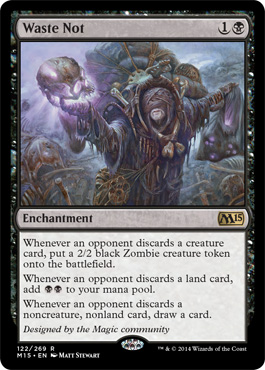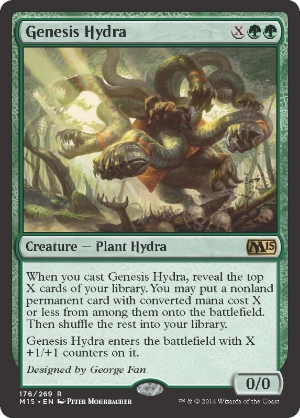If you’re remotely a fan of Magic: the Gathering by now you’ve noticed the previews solidly flowing in over the last two weeks. Now if you’re more than a casual observer you’ve certainly noticed many of the new changes coming down the line in the set. Now, if you haven’t noticed all of them, I’m here to show you after the jump.
There are a decent amount of changes coming down this year. Most of them deal with the card frames having an update for the first time since the Eighth Edition Core Set in 2003, so a little over ten years. This one isn’t as jarring as the last, but comes with a few really interesting updates. Prompting the frame change is some information additions and a font change. Aaron Forsythe, Director of Magic R&D, has an explanation of the changes, but first I’ll post Waste Not, the card we helped create, to illustrate the changes.
1) The font
Since its inception, Magic has used off-the-shelf fonts on its cards. As a brand, we feel that we’ll be better served by having our own unique proprietary font—something with a little edge and character that is still very readable.
In general, we liked the heaviness and shape of the “Matrix Bold” font we’d been using previously, so there are a lot of similarities between the old font and the new, named “Beleren,” which should alleviate any jarring feeling when you mix the two together in decks.
2) The holofoil stamp
You’ll notice a little silver oval in the bottom center of Waste Not. That’s a new unique holofoil stamp that we’re applying to all rares and mythic rares going forward. This stamp makes those cards feel more special, as well as guarantees authenticity.
Commons, uncommons, and basic lands will not feature this stamp.
3) The collector info
In the lower left of the card is a series of letters and numbers that indicate the card’s collector number (122/269), rarity (R), set (M15), and language (EN). The little dot between the set and the language will be a star on premium cards, so just about everything you’d ever need to know about a card’s edition is in one easy-to-read place.
Making the bottom of each card black to accommodate this information was not an easy decision, and may be the most disconcerting part of this frame update, but it was done with the best of intentions. This information is machine-readable by recognition software at our production plants. It will help eliminate the rare packaging error, like cards sneaking into the wrong expansion’s boosters.
4) Decreased border size
In order to fit all this cool new stuff on the cards, we’ve reduced the width of the black border by almost a millimeter all the way around. This reclaimed real estate allows us to have slightly bigger art and text boxes as well.
5) The designer credit
You’ll notice that we gave you all credit for making this card in the place normally occupied by flavor text—”Designed by the Magic community.” This is the first time we’ve ever given credit for a specific card design on the card itself, and it’s you! You should be very proud! While every card going forward won’t feature a designer credit (kinda sad, really), there are a handful of others in Magic 2015, specifically, that will. (You’ll have to wait on those details! It’s cool, I promise!)
Those are the major changes to the cards themselves. The other big one, as implied a few times above, came about to the design process. Fifteen cards in Magic 2015 (well done there, right) were designed by people outside Wizards of the Coast. Fourteen famous game designers from a multitude of backgrounds were asked to design a card to go into the set. By now, all of the cards have been spoiled, so we’ll list the designers and the card they made.
- George Fan: designer of Plants vs Zombies designed the above Genesis Hydra
- Mike Krahulik & Jerry Holkins: Gabe and Tycho, creators of Penny Arcade designed Avarice Amulet
- Markus Persson: “Notch,” creator of Minecraft and founder of Mojang designed Aggressive Mining
- Richard Garriot: “Lord British,” creator of the Ultima series designed Shield of the Avatar
- David Sirlin: designer on Super Street Fighter II Turbo HD Remix, Yomi designed Master of Predicaments
- Rob Pardo: chief creative officer at Blizzard, lead designer of World of Warcraft designed Xathrid Slyblade
- Isaiah Cartwright: lead game designer for Guild Wars 2 designed Warden of the Beyond
- Justin Gary: designer of Ascension: Chronicle of the Godslayer and Solforge designed Spirit Bonds
- Stone Librande: lead designer at Riot Games, designer of Diablo 3, creative director of SimCity designed Goblin Kaboomist
- Brian Fargo: founder and CEO of inXile Entertainment, director of Bard’s Tale, Wasteland, executive producer of Fallout designed Yisan, the Wanderer Bard
- Mike Neumann: Gearbox Software, creative director on Borderlands designed Chasm Skulker
- James Ernest: owner and lead designer for Cheapass Games, designer of Kill Doctor Lucky designed Hot Soup
- Edmund McMillen: indie designer of Super Meat Boy, featured in Indie Game: The Movie desiged Cruel Sadist
- Brad Muir: game designer at Double Fine Productions leading Massive Chalice, project lead onIron Brigade designed Ob Nixilis, Unshackled
The cards range the gamut from ridiculous, to powerful, to entertaining and hit both uncommon and rare for rarity. You can see the full spoiler for Magic 2015 here. Take a look and let us know what you think in the comments below.





